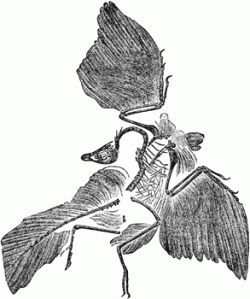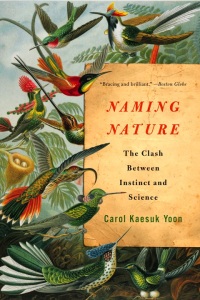I grew up in the city. As far as animals go, I prefer not to get too close. Still, I remember the thrill of spotting a flock of parrots perched in a tree on the south side of Chicago. Originally from Argentina, these birds somehow thrived, paradoxically enough, in the neighborhood surrounding the Museum of Science and Industry. Their garish green feathers formed a beautiful contrast with the gray, gritty buildings. It was a visceral experience.
But birdness isn’t an easy issue these days. Consider Archaeopteryx. Until quite recently, scientists gave it the status of earliest known bird. Crucially, it had feathers. According to the fossil record, it also had a wishbone, a hand with three fingers, and long arms. These features distinguished the 150-million-year-old creature from dinosaurs, and qualified it for birdness.
But now scientists in China have reported the discovery of another bird-like fossil, Xiaotingia zhengi. And they are using it to claim that Archaeopteryx isn’t actually a bird at all. Instead, they argue in the July 28 issue of Nature, Archaeopteryx belongs to a group of nonavian feathered dinosaurs, alongside Xiaotingia zhengi and another dinosaur, Anchiornis.

Archaeopteryx fossil, first discovered in Germany 150 years ago.
It’s an interesting debate, particularly because most people probably consider “nonavian feathered” an oxymoron. Feathers mean birdness (right?). But in constructing a new taxonomy, scientists are using a wider variety of details than most ordinary people would. Jaws, for example. Fossil records show that both Archaeopteryx and Xiaotingia zhengi have lightly built jaws, which contrast with the heavier jaws of the first uncontroversial birds, and imply different feeding habits.
Writer Carol Kaesuk Yoon has argued that modern scientific approaches to taxonomy — not just the consideration of details like jaws, but also DNA sequencing and the re-definition of “species” in strictly evolutionary terms — have alienated ordinary people from nature. We no longer trust the names we give to animals and plants, she argues, because science stands too ready to prove them incorrect. As a result, we have distanced ourselves from the natural world that surrounds us.
In Naming Nature: The Clash Between Instinct and Science (2009), Yoon shows that all humans have a basic instinct to name nature. Every culture uses names — but suprisingly, their naming systems do not exhibit as much variety as one might expect, suggesting that we are born with a sort of innate taxonomy. Furthermore, the capacity to name living things can be selectively impaired as the result of stroke, suggesting that one area of the human brain is specialized for naming nature. Yoon urges readers to get re-claim their innate taxonomies from the vagaries of science, and to experience a closer relationship with the natural world.
I like Yoon’s argument, partly because she uses some of the same evidence that linguists use when we try to show that all humans share certain language abilities (universal tendencies across cultures, selective impairment of brain function). And I must be her target audience, because I have a firmer grip on the taxonomy of commercial breakfast cereals than on the various species of birds.
But Yoon’s argument also strikes an anti-intellectual note. Shouldn’t we be trying to challenge our instincts, rather than blindly trusting them? And if we find do find evidence that challenges our instincts, shouldn’t we engage with it, rather than retreat? Anyone can read about Archaeopteryx, examine the fossil diagrams, and decide for themselves whether the lightly-built jaws trump the feathers. In fact, a good debate offers the perfect way to draw people further into the natural world, not away from it.
For the past fifteen years, the famous New York deli Zabar’s has apparently been selling “Lobster Salad” that contained no lobster. The ingredients: wild freshwater crawfish, mayonnaise, celery, salt and sugar. The Maine Lobster Council heard about this and protested. But Zabar’s fought back. “If you go to Wikipedia, you will find that crawfish in many parts of the country is referred to as lobster,” co-owner Saul Zabar told The New York Times. So what is a lobster? The answer is up for debate, even among non-scientists.
I’m also not sure that I buy Yoon’s argument about the relationship between experiencing the natural world and naming it. Surely we can do one without the other.
I live in the country now. Like it or not, animals are in my face. My favorite bike trail borders a wildlife sanctuary established by the Massachusetts Audobon Society. On most days I see the usual crew of robins, etcetera. But once in a great while, I see a more unusual bird. Its gray body forms a sober backdrop for the exuberant splashes of yellow on its wings. I could look it up in a birding book, but the truth is that I don’t want to name it. Its presence in my life is fleeting, ephemeral, and beautiful. Maybe its namelessness is part of that beauty.


I love it!
Thanks, Sonya!
From dinosaurs to Zabar’s in one elegant essay. This makes me think of the unease I always feel when told the tomato is actually a fruit. The scientific requirements of fruitness do not resonate with my innate taxonomy!
Also, I wish I had some of that lobster salad right now, whatever might be in it.
Tomato is a perfect example. Nobody believes that thing is a fruit!
Zabar-wise, I’ll take a blintz, thank you very much.